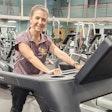![[Photos courtesy of State University of New York College at Cortland Student Life Center]](https://img.athleticbusiness.com/files/base/abmedia/all/image/2018/07/ab.Nirsa718_feat.png?auto=format%2Ccompress&q=70&w=400)
In early May, two prospective students — Native American brothers from New Mexico — were detained by campus police on a tour at Colorado State University after a parent claimed they made her "nervous." Audio of the parent's 911 call reveals that the brothers joined the tour late, were behaving "just really odd" and wore "black clothing." News of the incident quickly went national and became another recent example of racial profiling.
"The tour incident and its implications have troubled and angered many of us on campus, as well as many of our alumni and people with no connection to CSU," university president Tony Frank wrote in a message posted on CSU's website. "The emotions released have ranged from sadness to frustration to anger, all flowing from a reservoir of sympathy created by imagining ourselves or our children in this situation. This empathy unmasks the fundamental unfairness at play and creates a cognitive dissonance with who we are and who we aspire to be. ... There is no place for hate at Colorado State University, and we will not be silent when we see it."
CSU has a history of making noise when it comes to inclusionary policies, and nowhere is that more apparent than in the department of Campus Recreation.
"We're in this field that creates all of these wonderful opportunities for people to be socially engaged, to be physically active, to be well based on whatever that term means for them," says Erin Patchett, associate director of administration for CSU Campus Recreation, as well as a member of the NIRSA Commission for Equity, Diversity, and Inclusion and co-author of a report titled Inclusive Recreation: The State of Campus Policies, Facilities, Trainings, and Programs for Transgender Participants.
"If we don't have policies in place that support everyone for who they are, I guarantee people are missing out on the benefits of what our field does," she continues. "We're grateful we have an administration that supports its staff in these types of issues. Social justice is one of the overarching principles of the CSU community."
To that end, when CSU renovated its Student Recreation Center in 2010, officials took a progressive approach and included gender-inclusive restrooms and changing spaces as part of the design. The department also has its own Inclusivity committee to ensure it is providing services, programs and facilities to people regardless of race or ethnicity, gender identity or expression, sexual orientation, or religious and spiritual beliefs.
Gender inclusivity
Anyone — including families with young children and individuals with special needs — is allowed to use the university's gender-inclusive facilities, some of which include day-use lockers and private bathrooms with a toilet, sink, shower and urinal. The university now is in the process of retiring the "gender inclusive" tag in favor of "all gender" terminology and signage.
As part of CSU's transparent approach to gender identity and expression, Campus Recreation spends a significant amount of time training student-employees and other staff members. One common scenario used during education sessions is a patron complaining about someone in the women's locker room who doesn't look like a woman.
"When that happens, what do you do?" Patchett asks. "We encourage the students to find their own words and explain that the person may not look like a woman but identifies as a woman, so that person is welcome in the women's locker room. We also then offer alternatives to the person who might be uncomfortable, such as a single-use space."
The major evolution of spaces commonly referred to for decades, even in campus recreation facilities, as "family changing rooms" is being embraced to varying degrees by colleges and universities around the country — from maintaining only traditional men's and women's spaces to incorporating single-user spaces within the confines of a larger locker room.
"Right now, they're all kind of handling it differently," says Erik Kocher, a principal at Hastings+Chivetta Architects, a St. Louis-based firm that designs many campus recreation facilities. "There's not a handbook or anything that says, 'This is how you should do it,' and there's no planning standard for it yet."
Beyond privacy
Creating additional privacy in campus recreation centers is only part of the social justice equation.
"Diversity, equity and inclusion are buzzwords in higher education and around the nation," says André Love, executive director of University Recreation at the University of Alabama. "A lot of times when we talk about them, it's about fairness in how we promote things, it's about fairness in treatment and access to programs and facilities. It's always going to be a hot topic for us because we all value people."
Since 2015, NIRSA Championship Series events have adhered to an updated set of policies and tournament materials regarding transgender athlete participation.
"We want to take down the barriers and make this as easy as possible for people to participate," says Brooke Turner, Alabama's associate director of programs for University Recreation, who was heavily involved in the development of those policies and sought out individuals with a variety of perspectives. "Everyone doesn't start in the same place on things like this, and I think it's important that you have people with different viewpoints involved. If you put a group of people together who were all strong advocates for the transgender community, you might disenfranchise another group. The key is to find that balance to bring out different sides of the conversation."
Also at Alabama, the $10 million Stran-Hardin Arena for Adapted Athletics opened in January adjacent to the Student Recreation Center. The two-story facility includes an NCAA-regulation wheelchair basketball court, locker rooms, an athletic training room, and a strength and conditioning room.
Although it is operated under the purview of the university's College of Education, Alabama's adapted athletics program has a strong partnership with University Recreation, Love says, and the two entities worked closely on designing bathrooms, locker rooms and other elements of the new facility.
"When we start talking about inclusivity, often our discussions revolve around a specific population, whatever that population may be," Turner says. "And if we're doing a good job in having those conversations — especially with our students — the end goal is to make them more aware of the differences around us. It's not specific to one group of people, but how can we make things more inclusive overall."
This article originally appeared in the July|August 2018 issue of Athletic Business with the title "How campus recreation advances social justice." Athletic Business is a free magazine for professionals in the athletic, fitness and recreation industry. Click here to subscribe.





































